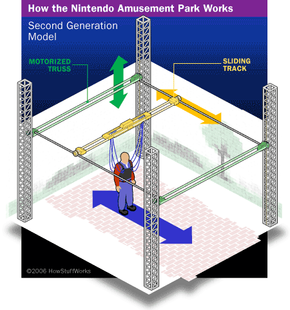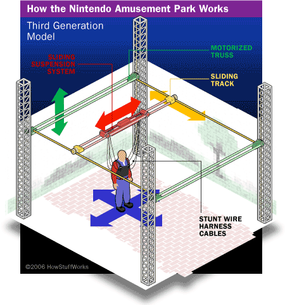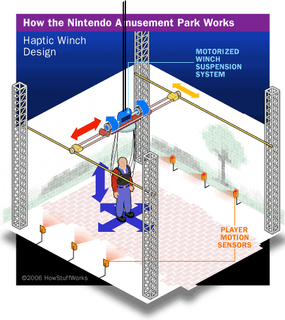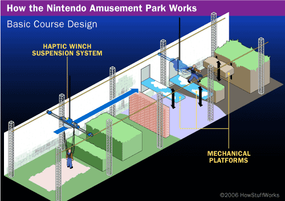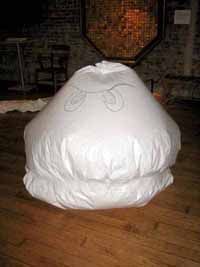In the 1982 movie "Tron," a programmer goes into a computer world, where he must compete in the gladiator-style games he helped design. For many gamers, possessing the powers, living the life and fighting the battles of their favorite characters would be a dream come true. Virtual reality can make this possible, but it's not the only solution. What if you could build a video-game environment in the real world with a system that would allow you to perform all of the game's actions and moves in real time and space? A team of three New York University students -- Daniel Albritton, Quanya Chen and Noah Shibley -- is doing just that with one of the most popular video games ever produced: "Super Mario Bros." They're calling their creation "Nintendo Amusement Park," and with it, they're helping to evolve a new area of science known as physically-augmented reality.
In this article, we'll give you a behind-the-scenes tour of the Nintendo Amusement Park and explain the differences between augmented reality, physically-augmented reality and virtual reality. We'll also describe how the parts of the Nintendo Amusement Park work together and take a look at some similar projects.
Advertisement
The name "Nintendo Amusement Park" is actually a misnomer, because an amusement park is a collection of rides, games and other forms of entertainment. It's really a single "ride" -- a real-life interactive adventure that allows players to dress up as Mario or Luigi, enter the Mushroom Kingdom and perform the actions that the heroes perform in the video game. Players can jump over obstacles, land on and ride moving platforms, and smash enemies. They can even collect gold coins and punch power-up boxes.
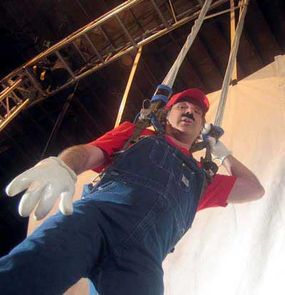
How do you give normal human beings the superhuman abilities Mario and Luigi have in the video-game world? You help them jump, of course -- and jump high. Jumping is just one requirement, though. The other is the world itself -- the Mushroom Kingdom complete with its moving platforms, obstacles and enemies. The designers plan to use a variety of mechanical systems and objects to duplicate these effects and create a large, navigable obstacle course. When complete, the Nintendo Amusement Park will be a 100-meter-long course that fully replicates the side-scrolling, platform action of "Super Mario Bros." To simulate the various worlds and levels of the video game, the designers will build different challenge areas -- or courses.
That's the ultimate vision, anyway. Right now, the park exists as a much simpler prototype, with plans for a gradual, phased implementation of the more complex gaming environment. Let's look at the prototype in greater detail.
The Prototype
The Nintendo Amusement Park prototype recreates the core elements of "Super Mario Bros" on a smaller, simpler scale. Although it's fairly crude, the prototype demonstrates the basic principles and technologies necessary to recreate "Super Mario Bros" in the real world. Those parts are:
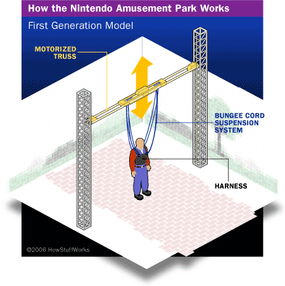
- A motorized truss that acts as a support structure and attachment point for the suspension system.
- A suspension system that boosts players' jumps.
- A harness that connects players to the suspension system.
- An obstacle course that replicates the physical challenges of the video game. The obstacle course in the prototype consists of inflatable objects and foam props placed on the ground, balloons attached to the background sheet and boxes suspended on wires from the overhead truss.
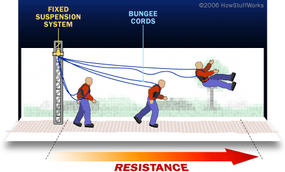
While the player has great vertical mobility in this system, he doesn't have much forward or lateral (side-to-side) mobility because the suspension system is attached to fixed points on the truss. The farther he moves from the fixed point, the more the bungee cords pull him back. This makes it difficult to have an interaction that takes place over a long horizontal distance, a defining characteristic of "Super Mario Bros." To solve this problem, the designers have several modifications in mind for future versions of the game. In the next section, we'll look at these modifications.
Advertisement

